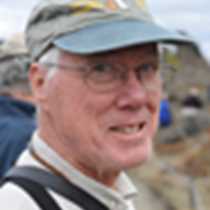Petersburg, Alaska
We have been exploring Alaska the majestic – giant rainforest trees of Sitka spruce, Western hemlock, and Western red cedar towering over 50 meters (160 plus feet) in height. Yesterday, in Misty Fjords National Monument, we gazed in awe at glacially-carved cliffs rising nearly vertically 3,000 feet above the water of Rudyerd Bay. Our ship was dwarfed by a waterfall cascading down from alpine snowfields far above us. Today we explored Alaska at another scale. Early morning (and I do mean early) brought us a very low tide and an opportunity for a pre-breakfast exploration of tide pools at Agate Beach, on Kupreanof Island ... not looking up at the cliffs and treetops but down at the diversity of life in pools left by the falling tide: anemones, sea stars, frilly red sea cucumbers, sea urchins, limpets, chitons, and a brilliant orange hermit crab, among others.
We moved to the town of Petersburg. It is not a usual tourist stop but a working Alaskan fishing community. Many took the opportunity for a flightseeing excursion over nearby LeConte Glacier. A century ago fish caught in the waters around Petersburg were packed in ice from the glacier and shipped by steamship and railroad to markets across America, and Petersburg became one of Alaska’s most successful fishing towns. Across the water from Petersburg we followed a boardwalk trail through the forest and suddenly emerged into a bog. There we found an array of plants that are unique to this habitat. Bogs form in the Alaskan forest where drainage is impeded and the water table reaches the surface. Bog plants must be tolerant of acid soils and low levels of available nutrients. They tend to be small and widely spaced. The lovely red round-leaved sundew shown above glistening with raindrops has found its own solution to life in the nutrient-poor bog: it catches insects in sticky glands and digests them for a nutrient supplement.
Our day concluded with a return to the majestic. After dinner we encountered a humpback whale newly returned from her winter in Hawaii, accompanied by her young calf. The calf put on a show of exuberance, repeatedly breaching and slapping the water, to the intense enjoyment of all. Finally, with the rays of the evening sun shining through a hole in the clouds and a full moon rising on the opposite side of the sky, we went to our beds, tired but contented.
We have been exploring Alaska the majestic – giant rainforest trees of Sitka spruce, Western hemlock, and Western red cedar towering over 50 meters (160 plus feet) in height. Yesterday, in Misty Fjords National Monument, we gazed in awe at glacially-carved cliffs rising nearly vertically 3,000 feet above the water of Rudyerd Bay. Our ship was dwarfed by a waterfall cascading down from alpine snowfields far above us. Today we explored Alaska at another scale. Early morning (and I do mean early) brought us a very low tide and an opportunity for a pre-breakfast exploration of tide pools at Agate Beach, on Kupreanof Island ... not looking up at the cliffs and treetops but down at the diversity of life in pools left by the falling tide: anemones, sea stars, frilly red sea cucumbers, sea urchins, limpets, chitons, and a brilliant orange hermit crab, among others.
We moved to the town of Petersburg. It is not a usual tourist stop but a working Alaskan fishing community. Many took the opportunity for a flightseeing excursion over nearby LeConte Glacier. A century ago fish caught in the waters around Petersburg were packed in ice from the glacier and shipped by steamship and railroad to markets across America, and Petersburg became one of Alaska’s most successful fishing towns. Across the water from Petersburg we followed a boardwalk trail through the forest and suddenly emerged into a bog. There we found an array of plants that are unique to this habitat. Bogs form in the Alaskan forest where drainage is impeded and the water table reaches the surface. Bog plants must be tolerant of acid soils and low levels of available nutrients. They tend to be small and widely spaced. The lovely red round-leaved sundew shown above glistening with raindrops has found its own solution to life in the nutrient-poor bog: it catches insects in sticky glands and digests them for a nutrient supplement.
Our day concluded with a return to the majestic. After dinner we encountered a humpback whale newly returned from her winter in Hawaii, accompanied by her young calf. The calf put on a show of exuberance, repeatedly breaching and slapping the water, to the intense enjoyment of all. Finally, with the rays of the evening sun shining through a hole in the clouds and a full moon rising on the opposite side of the sky, we went to our beds, tired but contented.




